Weightlifting platforms are a great way to protect your floor, lifting equipment, and even reduce noise and vibration. But do you need one? Here’s a look at the benefits of lifting platforms and some alternatives.
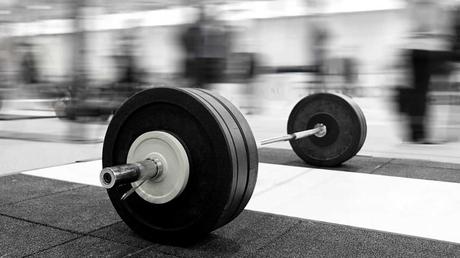
Weightlifting platforms are a surprisingly necessary piece of gym equipment!
You’ll see them in just about every commercial gym around the country because of how useful they are—in more ways than you realize.
When setting up your home gym, it’s a good idea to consider investing in an Oly or deadlift platform in addition to your squat rack.
They can make all the difference for both your training and the protection of your home.
Below, we’ll take a much closer look at weightlifting platforms, including what they are, what types of platforms are available, how they benefit you, and what you can do if you don’t have the money or space for a proper weightlifting platform.
By the end of this post, you’ll know everything necessary to set up this important—dare I say, essential?—piece of equipment.
Let’s jump right in!
Weightlifting Platforms – What Are They?
Weightlifting platforms are, to put it simply, sturdy platforms designed to place beneath a power rack or squat rack, something to put between your heavy weights and the floor of the gym or your home gym.
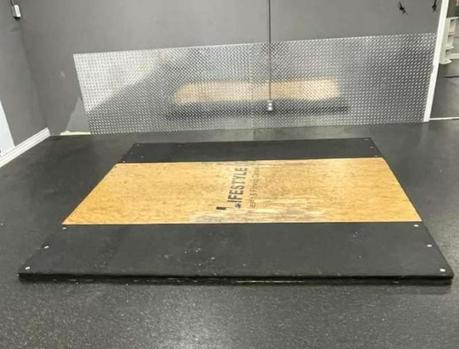
There are two basic types of weightlifting platforms:
 Olympic lifting platform
Olympic lifting platform

These platforms are typically built to be larger, usually 8 feet by 8 feet, and are often thicker (8 to 12 inches thick).
They’re utilized for more technical Olympic lifts, such as snatches, cleans, etc.
When performing these difficult, technical lifts, it’s common to drop the barbell from an overhead position.
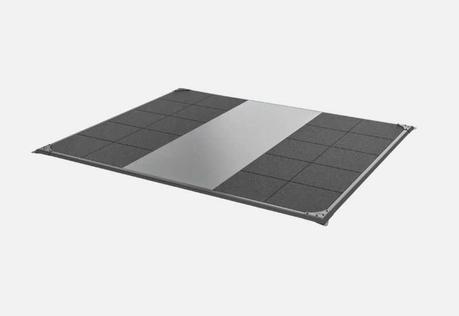
The amount of weight hitting the ground is significant, meaning the amount of force generated is significant.
Hence, the platforms are thicker in order to provide protection for your floor and the weight plates you’ve loaded onto the barbell.
 Deadlift platform
Deadlift platform

Most deadlift platforms, including the iconic Rogue deadlift platform, are smaller and leaner than Olympic lifting platforms.
They’re often 8 feet wide (more than wide enough to accommodate the barbell) but only 4 feet long.
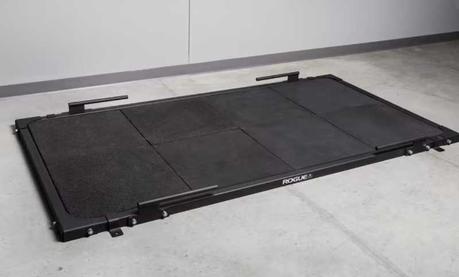
The center is made using wood to provide a solid platform for you to stand, and the outer edges are made with rubber to provide cushioning for your weights and the floor.
With deadlifts, you don’t drop the weight from quite as high (waist level), so the platform doesn’t need to be as thick or offer as much cushioning. Thus, most deadlift platforms are around 4 inches thick.
The Benefits of Using a Lifting Platform
There are a surprising number of reasons to use a lifting platform, benefits that will make them a crucial addition to any gym where heavy weights are going to be lifted.
 Benefit #1: Protect Your Floor
Benefit #1: Protect Your Floor

The #1 benefit of a lifting platform is that it protects your floor from damage.
A lot of home gyms are set up in the garage or basement, where there is nothing but concrete under whatever mats or flooring you’ve spread out in your gym.
While you might not think concrete needs protection, the truth is that repeated impacts from very heavy weights (especially if you’re deadlifting hundreds of pounds) or weights dropped from above your head can, over time, break or crack even concrete.
The last thing you want is to damage the foundation of your home by dropping heavy weights. A lifting platform will provide a layer of cushioning to diffuse the direct impact against your floor to protect the concrete.
And the platform becomes even more essential if you’re working in your living room, on your balcony, or in any other room in the house where the floors are built from wood.
You’re going to absolutely need something to protect the floorboards and struts from damage when dropping heavy weights.
 Benefit #2: Protect Your Weights
Benefit #2: Protect Your Weights

Your floor isn’t the only thing likely to be damaged when you drop heavy weights; the weights themselves can sustain damage.
Most of the weights you’ll buy for deadlifting and Olympic lifts are made from sturdy steel or iron and encased in a layer of protective rubber. This is typically more than enough to protect it from the usual wear and tear caused by regular gym training, even lifts where you drop the weight from waist or head height.
But if those weights slam directly into hard, unyielding concrete, they will sustain damage over time. The rubber will crack or wear out, and there’s even the risk of the metal plate itself being cracked.
Using a lifting platform with rubber and wood cushioning will ensure your barbells and bumper plates last longer and sustain significantly less damage every time you drop them.
 Benefit #3: Anchor Your Squat Rack
Benefit #3: Anchor Your Squat Rack

This is one of the primary reasons for using a lifting platform, especially in home gyms!
When you set up a squat rack—be it a two-post or four-post rack—you’re going to need some way to anchor it in place and keep it from tipping over.
See also: What Should I Put Under My Power Rack?
In commercial gyms, the rack is typically bolted into the hard concrete beneath the flooring.
However, you might not have the tools to drill the solid bolts directly into the concrete, or you don’t want to damage the concrete floor of your garage or basement by anchoring the squat rack directly.
A lifting platform serves as the perfect anchor for your squat rack. In fact, they’re often designed to be compatible with squat racks, using thicker, sturdier wood for the center of the platform where you’ll be bolting down the rack.
It’s not only safer, but it’s also easier—most people have the tools necessary to drive a bolt into the wooden platform.
 Benefit #4: Practice for Competitive Lifting
Benefit #4: Practice for Competitive Lifting

Whether you’re a CrossFitter, Strongman, or Olympic lifter, you’re going to want your training setup to emulate the setup of whatever competition you plan to compete it.
That means using the right equipment—from barbell to weight discs to rack to platform.
With the weightlifting platforms, you can train as if you’re on that stage already, and make every lift count.
See also: 6 Reasons the Rogue 8×8 Olympic Platform is Awesome
Not only that, but you’ll create the optimal training setup to use in preparation for your competition. You’ll have a solid, slip-resistant surface that provides secure footing so you won’t have to worry about your feet while focusing on your lift.
The platform makes it possible to train in preparation for your next competition—and every competition thereafter.
 Benefit #5: Separate Your Lifting Area
Benefit #5: Separate Your Lifting Area

This is a great benefit for those who share home gym space with their partner, spouse, buddies, or kids.
Having a separate area where you can work on those heavy lifts safely is game-changing for your tandem or group home workouts.
While one of you is practicing your deadlifts or Olympic lifts, the others can be safely out of the way of the falling/dropping/bouncing barbell.
Having multiple work stations set up a safe distance apart is a great way to ensure no one is at risk when working out together.
 Benefit #6: Feel Like a Badass
Benefit #6: Feel Like a Badass

Let’s be honest: this is one of the best benefits of a weightlifting platform!
With a dedicated lifting platform in your home gym, you’ve got a place where you can grunt, strain, heave, and bang around those weights like an Olympic lifter or bodybuilder, and it will make you feel like a total badass every time you do it.
Best of all, you can trust your weights and floors are protected, so you can train like a beast in your home gym.
As you can see, there are a lot of reasons to install a weightlifting platform in your home!
Alternatives to Lifting Platforms for Home Gyms
You might be looking at your home gym and thinking, “There’s just no way I have the space for a weightlifting platform!”
An 8×8’ or even a 4×8’ platform can be far too large to fit in your basement or even in a two-car garage, especially if you’ve got a lot of other gym equipment or stored items taking up room.
The good news is that there are a few alternatives to lifting platforms that will help you train hard even in limited space:
Deadlift pads
Deadlift pads also called crash pads and silencer pads, are basically thick foam pads encased in sturdy nylon fabric that you place directly beneath the spot where you intend to drop the weight.
They’re far from the sturdiest option—over time, the foam will compress and the nylon is likely to crack or rip from repetitive drops—but they’re small enough that you can stack them or lean them against the wall so they’re out of the way when not in use.
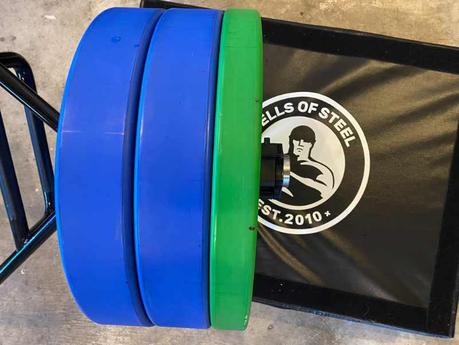
When the time comes to deadlift, just place the pads in their place, knock out your deadlifts, and drop the weight safely onto the pads.
Deadlift pads will protect your floors and weights, but unlike a lifting platform, won’t give you an elevated, stable surface to train on. It’s a good option for anyone with very little space to train, though!
Gym mats
Gym mats are usually rubberized or synthetic mats manufactured specifically for use at gyms. They’ll offer good grip as well as impact-absorption and cushioning.
You can use them to create your own small deadlifting space, and stacking a few like deadlifts pads beneath the spot where you’ll drop your weights will help to absorb impact.
However, fair warning: these mats tend to be heavy and cumbersome, not the easiest to move around. You might want to set up your lifting station and leave the mats in place throughout your entire training session.
Horse stall mats
Horse stall mats have been used as a gym mat alternative for decades.
They’re built from similar materials, function virtually identically, and provide excellent cushioning for your weights.
They’re also easier to find in rural areas, and may end up costing less than gym mats.
DIY lifting platform
Try for a more professional setup in your home even if you have less space by DIYing your own lifting platform. You can build a platform that’s the full 8 feet long but only 2 or 3 wide (depending on your space).
All you need is wood (plywood or OSB works great), rubber mats, and glue.
You can customize the size of your platform based on the space available in your home, and build it specifically to fit around your other gym equipment.
The Bottom Line
A weightlifting platform is more than just a game-changing addition to a home gym; it’s a crucial piece of workout equipment that will take your training sessions to the next level and protect your investments (your home and your weights) for years to come.
Whether you opt for a deadlifting platform, an Olympic lifting platform, or one of the alternatives we suggested above, you’ll be glad to have a dedicated, separate place to work on your deadlifts and Olympic lifts.
Now, get to lifting and crushing those PRs!
More Stuff Like This
Westside Hole Spacing: What is it, What are the Benefits, and the Racks That Have It. One of the best features of a new squat rack is Westside hole spacing. Here’s a detailed dive into what Westside hole spacing is, where it started, the benefits, and which squat racks have it.
Rack Pull vs Deadlift: Benefits, Differences, and How to Program Both for Max Progress. Ready to take your lifting to the next level? Here is a detailed look at the differences between rack pulls vs deadlifts and how to use BOTH for more strength and muscle in the gym.
The Best Squat Racks with Pull-Up Bars (and How to Choose). Ready to take your pull-up training to the next level in the comfort of your own home? Here are the best squat racks with pull-up bars for every budget and lifter.
